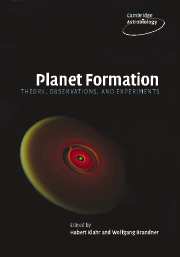Book contents
- Frontmatter
- Contents
- Preface
- Acknowledgments
- 1 Historical notes on planet formation
- 2 The Formation and Evolution of Planetary Systems: placing our Solar System in context
- 3 Destruction of protoplanetary disks by photoevaporation
- 4 Turbulence in protoplanetary accretion disks: driving mechanisms and role in planet formation
- 5 The origin of solids in the early Solar System
- 6 Experiments on planetesimal formation
- 7 Dust coagulation in protoplanetary disks
- 8 The accretion of giant planet cores
- 9 Planetary transits: a first direct vision of extrasolar planets
- 10 The core accretion–gas capture model for gas-giant planet formation
- 11 Properties of exoplanets: a Doppler study of 1330 stars
- 12 Giant-planet formation: theories meet observations
- 13 From hot Jupiters to hot Neptunes … and below
- 14 Disk–planet interaction and migration
- 15 The brown dwarf–planet relation
- 16 Exoplanet detection techniques – from astronomy to astrobiology
- 17 Overview and prospective in theory and observation of planet formation
- References
- Index
14 - Disk–planet interaction and migration
Published online by Cambridge University Press: 14 September 2009
- Frontmatter
- Contents
- Preface
- Acknowledgments
- 1 Historical notes on planet formation
- 2 The Formation and Evolution of Planetary Systems: placing our Solar System in context
- 3 Destruction of protoplanetary disks by photoevaporation
- 4 Turbulence in protoplanetary accretion disks: driving mechanisms and role in planet formation
- 5 The origin of solids in the early Solar System
- 6 Experiments on planetesimal formation
- 7 Dust coagulation in protoplanetary disks
- 8 The accretion of giant planet cores
- 9 Planetary transits: a first direct vision of extrasolar planets
- 10 The core accretion–gas capture model for gas-giant planet formation
- 11 Properties of exoplanets: a Doppler study of 1330 stars
- 12 Giant-planet formation: theories meet observations
- 13 From hot Jupiters to hot Neptunes … and below
- 14 Disk–planet interaction and migration
- 15 The brown dwarf–planet relation
- 16 Exoplanet detection techniques – from astronomy to astrobiology
- 17 Overview and prospective in theory and observation of planet formation
- References
- Index
Summary
Introduction
Directly after the discovery of the very first extrasolar planets around main-sequence stars it has become obvious that the new planetary systems differ substantially from our own Solar System. Amongst other properties one distinguishing feature is the close proximity of several planets to their host stars (hot Jupiters). As it is difficult to imagine scenarios to form planets so close to their parent star it is generally assumed that massive, Jupiter-like planets form further away, and then migrate inwards towards the star due to disk–planet tidal interactions. Hence, the mere existence of hot Jupiters can be taken as clear evidence of the occurence of migration. Interestingly, theoretically the possibility of migrating planets has long been predicted from the early 1980s.
Another observational indication that some migration of planets must have occured is the existence of planets in mean motion resonances. Due to converging differential migration of two planets both embedded in a protoplanetary disk they can be captured in a low-order mean motion resonance. The most prominent example is the system GJ 876 where the planets have orbital periods of roughly 30 and 60 days.
In this review we focus on the theoretical aspects of the disk–planet interaction which leads to a change in the orbital elements of the planet most notably its semimajor axis. We only treat systems with a single planet and do not consider planetery systems containing multiple planets.
Information
- Type
- Chapter
- Information
- Planet FormationTheory, Observations, and Experiments, pp. 216 - 235Publisher: Cambridge University PressPrint publication year: 2006
Accessibility standard: Unknown
Why this information is here
This section outlines the accessibility features of this content - including support for screen readers, full keyboard navigation and high-contrast display options. This may not be relevant for you.Accessibility Information
- 1
- Cited by
